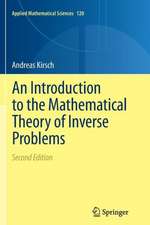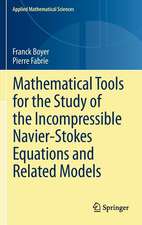Mathematical and Numerical Foundations of Turbulence Models and Applications: Modeling and Simulation in Science, Engineering and Technology
Autor Tomás Chacón Rebollo, Roger Lewandowskien Limba Engleză Hardback – 17 iun 2014
Authored by two experts in the area with a long history of collaboration, this monograph provides a current, detailed look at several turbulence models from both the theoretical and numerical perspectives. The k-epsilon, large-eddy simulation and other models are rigorously derived and their performance is analyzed using benchmark simulations for real-world turbulent flows.
Mathematical and Numerical Foundations of Turbulence Models and Applications is an ideal reference for students in applied mathematics and engineering, as well as researchers in mathematical and numerical fluid dynamics. It is also a valuable resource for advanced graduate students in fluid dynamics, engineers, physical oceanographers, meteorologists and climatologists.
| Toate formatele și edițiile | Preț | Express |
|---|---|---|
| Paperback (1) | 955.88 lei 6-8 săpt. | |
| Springer – 23 aug 2016 | 955.88 lei 6-8 săpt. | |
| Hardback (1) | 962.03 lei 6-8 săpt. | |
| Springer – 17 iun 2014 | 962.03 lei 6-8 săpt. |
Din seria Modeling and Simulation in Science, Engineering and Technology
-
 Preț: 410.88 lei
Preț: 410.88 lei - 18%
 Preț: 958.38 lei
Preț: 958.38 lei - 18%
 Preț: 784.13 lei
Preț: 784.13 lei - 15%
 Preț: 551.02 lei
Preț: 551.02 lei - 15%
 Preț: 642.68 lei
Preț: 642.68 lei -
 Preț: 392.60 lei
Preț: 392.60 lei -
 Preț: 388.34 lei
Preț: 388.34 lei - 18%
 Preț: 950.03 lei
Preț: 950.03 lei - 15%
 Preț: 643.84 lei
Preț: 643.84 lei - 15%
 Preț: 649.39 lei
Preț: 649.39 lei - 15%
 Preț: 644.18 lei
Preț: 644.18 lei - 20%
 Preț: 651.57 lei
Preț: 651.57 lei - 18%
 Preț: 1238.42 lei
Preț: 1238.42 lei - 15%
 Preț: 639.25 lei
Preț: 639.25 lei -
 Preț: 399.12 lei
Preț: 399.12 lei - 15%
 Preț: 650.19 lei
Preț: 650.19 lei -
 Preț: 387.58 lei
Preț: 387.58 lei -
 Preț: 392.97 lei
Preț: 392.97 lei -
 Preț: 396.24 lei
Preț: 396.24 lei - 15%
 Preț: 661.32 lei
Preț: 661.32 lei -
 Preț: 396.24 lei
Preț: 396.24 lei - 18%
 Preț: 943.88 lei
Preț: 943.88 lei - 18%
 Preț: 1386.17 lei
Preț: 1386.17 lei - 15%
 Preț: 648.42 lei
Preț: 648.42 lei - 15%
 Preț: 648.24 lei
Preț: 648.24 lei -
 Preț: 405.06 lei
Preț: 405.06 lei - 15%
 Preț: 641.38 lei
Preț: 641.38 lei - 15%
 Preț: 649.71 lei
Preț: 649.71 lei - 18%
 Preț: 1220.88 lei
Preț: 1220.88 lei - 15%
 Preț: 640.06 lei
Preț: 640.06 lei - 18%
 Preț: 952.26 lei
Preț: 952.26 lei - 15%
 Preț: 640.88 lei
Preț: 640.88 lei -
 Preț: 383.50 lei
Preț: 383.50 lei - 18%
 Preț: 1232.26 lei
Preț: 1232.26 lei - 15%
 Preț: 644.49 lei
Preț: 644.49 lei - 15%
 Preț: 655.60 lei
Preț: 655.60 lei -
 Preț: 400.26 lei
Preț: 400.26 lei - 23%
 Preț: 657.13 lei
Preț: 657.13 lei
Preț: 962.03 lei
Preț vechi: 1173.21 lei
-18% Nou
Puncte Express: 1443
Preț estimativ în valută:
184.08€ • 192.20$ • 152.35£
184.08€ • 192.20$ • 152.35£
Carte tipărită la comandă
Livrare economică 04-18 aprilie
Preluare comenzi: 021 569.72.76
Specificații
ISBN-13: 9781493904549
ISBN-10: 149390454X
Pagini: 517
Ilustrații: XVII, 517 p. 18 illus., 9 illus. in color.
Dimensiuni: 155 x 235 x 26 mm
Greutate: 0.92 kg
Ediția:2014
Editura: Springer
Colecția Birkhäuser
Seria Modeling and Simulation in Science, Engineering and Technology
Locul publicării:New York, NY, United States
ISBN-10: 149390454X
Pagini: 517
Ilustrații: XVII, 517 p. 18 illus., 9 illus. in color.
Dimensiuni: 155 x 235 x 26 mm
Greutate: 0.92 kg
Ediția:2014
Editura: Springer
Colecția Birkhäuser
Seria Modeling and Simulation in Science, Engineering and Technology
Locul publicării:New York, NY, United States
Public țintă
ResearchCuprins
Introduction.- Incompressible Navier-Stokes Equations.- Mathematical Basis of Turbulence Modeling.- The k – ε Model.- Laws of the Turbulence by Similarity Principles.- Steady Navier-Stokes Equations with Wall Laws and Fixed Eddy Viscosities.- Analysis of the Continuous Steady NS-TKE Model.- Evolutionary NS-TKE Model.- Finite Element Approximation of Steady Smagorinsky Model.- Finite Element Approximation of Evolution Smagorinsky Model.- A Projection-based Variational Multi-Scale Model.- Numerical Approximation of NS-TKE Model.- Numerical Experiments.- Appendix A: Tool Box.
Recenzii
“The book is a valuable reference for the study ofthe mathematical foundations of several widely used turbulence models. It canbe recommended for advanced graduate students and researchers in mathematicaland numerical turbulence theory.” (Joachim Naumann, zbMATH 1328.76002, 2016)
Textul de pe ultima copertă
With applications to climate, technology, and industry, the modeling and numerical simulation of turbulent flows are rich with history and modern relevance. The complexity of the problems that arise in the study of turbulence requires tools from various scientific disciplines, including mathematics, physics, engineering, and computer science.
Authored by two experts in the area with a long history of collaboration, this monograph provides a current, detailed look at several turbulence models from both the theoretical and numerical perspectives. The k-epsilon, large-eddy simulation, and other models are rigorously derived and their performance is analyzed using benchmark simulations for real-world turbulent flows.
Mathematical and Numerical Foundations of Turbulence Models and Applications is an ideal reference for students in applied mathematics and engineering, as well as researchers in mathematical and numerical fluid dynamics. It is also a valuable resourcefor advanced graduate students in fluid dynamics, engineers, physical oceanographers, meteorologists, and climatologists.
Authored by two experts in the area with a long history of collaboration, this monograph provides a current, detailed look at several turbulence models from both the theoretical and numerical perspectives. The k-epsilon, large-eddy simulation, and other models are rigorously derived and their performance is analyzed using benchmark simulations for real-world turbulent flows.
Mathematical and Numerical Foundations of Turbulence Models and Applications is an ideal reference for students in applied mathematics and engineering, as well as researchers in mathematical and numerical fluid dynamics. It is also a valuable resourcefor advanced graduate students in fluid dynamics, engineers, physical oceanographers, meteorologists, and climatologists.
Caracteristici
Draws on the most current, cutting-edge research in the field Encompasses complementary numerical and theoretical aspects of fluid dynamics Compiles related information that cannot be found together in any other place Contains many lesser-known but useful mathematical and numerical tools Valuable as both a reference resource and as a graduate text Includes supplementary material: sn.pub/extras















